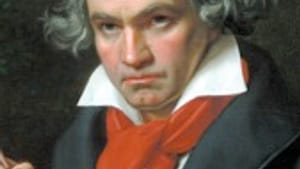Stay in the Loop
BSR publishes on a weekly schedule, with an email newsletter every Wednesday and Thursday morning. There’s no paywall, and subscribing is always free.
Second of a series of articles about understanding sonata-form.
In my previous essay—“You too can enjoy sonata-form” — I promised to “sell you on the beauties and pleasures of examining how this music is put together.” Here I am to fulfill my pledge.
As a starting point, I’ve picked the beginning of the second movement of Haydn’s 85th Symphony. These 90 seconds of music, aside from comprising one of the most elegant and economical tunes I know— it’s such a cool little piece! —contain all the essentials of sonata-form, albeit in embryonic form.
Notice that I used the term “embryonic” rather than “miniature.” Think of this tune as a sort of genetic blueprint for sonata-form, as something with seeds buried within it that can expand to fill up the space demanded by a piece that might be ten times as long.
The tune is in two clear sections, each of which is repeated. The second repeated section is exactly twice as long as the first one, and ends with an altered restatement of the first section. This organization is what I’m going to concentrate on here. But, for future reference, let’s take special note of some crucial details.
Listen to the difference between the two little ideas that make up the first section: this idea and its answer. Here they are again together. If you can listen to the low strings along with the melody, so much the better. But even if you can’t, just be aware of how the ground seems to shift underneath the beginning of the answer – even though the melodies are at first exactly the same– and how that slight shift makes the tune go off in a different direction.
Now listen again to the modified repeat of all that. Again, listen to the bottom voice, if you can. Instead of that moment of uneasiness and a new direction, the music instead drops anchor, as it were, and— for me, anyway— gives the feeling that it’s really reached a solid ending.
Together those last four links comprise the idea that is sonata-form’s reason for being. I’ll return to them in a later essay, but for now, just file them away.
Those indecipherable concert program notes
Since my goal is not only to explain how sonata-form works but also to demystify the terms you’re likely to encounter in concert program notes, perhaps it would be helpful to show how at least some of these terms apply to what we’ve been discussing.
The three basic terms you’re likely to encounter more than any others are exposition, development and recapitulation. The first repeated section of the Haydn tune— that is, its first 15 seconds— is the germ of a sonata-form exposition. It’s the modified repeat that's the germ of (no surprise here) a recapitulation. All that’s left is the first half of the second repeated section, which is the tiniest seed of a sonata-form development.
As I said, writing a movement in sonata-form involves taking the structure of this Haydn tune and making it bigger– much bigger. That’s easy to say, but it’s not so easy to hear without understanding what “making it bigger” means.
Beethoven: Longer than Haydn, and much bigger, too
Take this innocent-seeming moment in our Haydn example: the return to the tune’s modified restatement. Now here’s the same idea on a truly grandiose scale, as it occurs in the first movement of Beethoven’s Waldstein Piano Sonata. Listen to the beginning of the movement, the structural equivalent of the first seven seconds or so of our Haydn tune. This movement lasts about ten minutes, six or seven times longer than the Haydn tune. Believe me, despite what the clock on the wall might say, it feels much bigger than that.
Here’s what happens about six minutes later, as, after a great deal of musical turmoil and adventure, Beethoven gets ready to go back to the beginning.
This passage is an excellent (and admittedly extreme) illustration of one of sonata-form’s most appealing features: It doesn’t merely magnify Haydn’s basic structure; it dramatizes it. Instead of a simple little phrase that tells you we’re about to return to the beginning, Beethoven produces a veritable tidal bore of sound that washes you back into the sonata’s opening idea.
OK— this is a start. If your time calibration is set correctly, and if you can recognize a musical idea several minutes after hearing it, you’re well on the way to making sense of classical musical architecture on a large scale. But I’ve run out of space without warning you about what I imagine is a potential source of great confusion. So stay tuned for my next installment: “Slow Introductions and the Sonata-Form Game Clock.”
To read the next installment, click here.
In my previous essay—“You too can enjoy sonata-form” — I promised to “sell you on the beauties and pleasures of examining how this music is put together.” Here I am to fulfill my pledge.
As a starting point, I’ve picked the beginning of the second movement of Haydn’s 85th Symphony. These 90 seconds of music, aside from comprising one of the most elegant and economical tunes I know— it’s such a cool little piece! —contain all the essentials of sonata-form, albeit in embryonic form.
Notice that I used the term “embryonic” rather than “miniature.” Think of this tune as a sort of genetic blueprint for sonata-form, as something with seeds buried within it that can expand to fill up the space demanded by a piece that might be ten times as long.
The tune is in two clear sections, each of which is repeated. The second repeated section is exactly twice as long as the first one, and ends with an altered restatement of the first section. This organization is what I’m going to concentrate on here. But, for future reference, let’s take special note of some crucial details.
Listen to the difference between the two little ideas that make up the first section: this idea and its answer. Here they are again together. If you can listen to the low strings along with the melody, so much the better. But even if you can’t, just be aware of how the ground seems to shift underneath the beginning of the answer – even though the melodies are at first exactly the same– and how that slight shift makes the tune go off in a different direction.
Now listen again to the modified repeat of all that. Again, listen to the bottom voice, if you can. Instead of that moment of uneasiness and a new direction, the music instead drops anchor, as it were, and— for me, anyway— gives the feeling that it’s really reached a solid ending.
Together those last four links comprise the idea that is sonata-form’s reason for being. I’ll return to them in a later essay, but for now, just file them away.
Those indecipherable concert program notes
Since my goal is not only to explain how sonata-form works but also to demystify the terms you’re likely to encounter in concert program notes, perhaps it would be helpful to show how at least some of these terms apply to what we’ve been discussing.
The three basic terms you’re likely to encounter more than any others are exposition, development and recapitulation. The first repeated section of the Haydn tune— that is, its first 15 seconds— is the germ of a sonata-form exposition. It’s the modified repeat that's the germ of (no surprise here) a recapitulation. All that’s left is the first half of the second repeated section, which is the tiniest seed of a sonata-form development.
As I said, writing a movement in sonata-form involves taking the structure of this Haydn tune and making it bigger– much bigger. That’s easy to say, but it’s not so easy to hear without understanding what “making it bigger” means.
Beethoven: Longer than Haydn, and much bigger, too
Take this innocent-seeming moment in our Haydn example: the return to the tune’s modified restatement. Now here’s the same idea on a truly grandiose scale, as it occurs in the first movement of Beethoven’s Waldstein Piano Sonata. Listen to the beginning of the movement, the structural equivalent of the first seven seconds or so of our Haydn tune. This movement lasts about ten minutes, six or seven times longer than the Haydn tune. Believe me, despite what the clock on the wall might say, it feels much bigger than that.
Here’s what happens about six minutes later, as, after a great deal of musical turmoil and adventure, Beethoven gets ready to go back to the beginning.
This passage is an excellent (and admittedly extreme) illustration of one of sonata-form’s most appealing features: It doesn’t merely magnify Haydn’s basic structure; it dramatizes it. Instead of a simple little phrase that tells you we’re about to return to the beginning, Beethoven produces a veritable tidal bore of sound that washes you back into the sonata’s opening idea.
OK— this is a start. If your time calibration is set correctly, and if you can recognize a musical idea several minutes after hearing it, you’re well on the way to making sense of classical musical architecture on a large scale. But I’ve run out of space without warning you about what I imagine is a potential source of great confusion. So stay tuned for my next installment: “Slow Introductions and the Sonata-Form Game Clock.”
To read the next installment, click here.
Sign up for our newsletter
All of the week's new articles, all in one place. Sign up for the free weekly BSR newsletters, and don't miss a conversation.

 Dan Coren
Dan Coren
